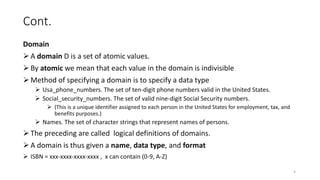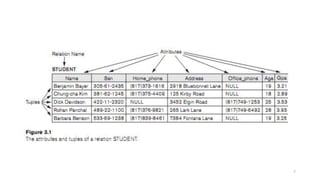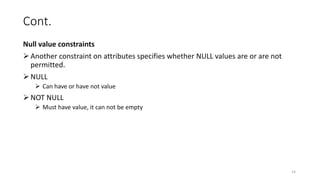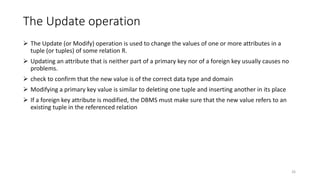Fundamentals of database system - Relational data model and relational database constraints
- 1. Fundamentals of Database systems Ministry of Higher Education Bamyan University Computer Science Department 1 Presented by : Mustafa Kamel Mohammadi Email : bamian.cs@gmail.com Relational data model and relational database constraints Fundamentals of database system 6th edition
- 2. Learning objective In his chapter you will learn Relational data model concepts Relational data model constraints Characteristics of relation 2
- 3. Relational Model Concepts The Relational model represents the database as a collection of relations. Each relation resembles a table of values Each row in the table represents a collection of related data values. A row represents a Real-world entity Relationship Table name and column names are used to help to interpret the meaning of the values in each row. In the formal relational model terminology A row is called a tuple A column header is called an attribute The table is called a relation The data type describing the types of values that can appear in each column is represented by a domain of possible values 3
- 4. Cont. Domain A domain D is a set of atomic values. By atomic we mean that each value in the domain is indivisible Method of specifying a domain is to specify a data type Usa_phone_numbers. The set of ten-digit phone numbers valid in the United States. Social_security_numbers. The set of valid nine-digit Social Security numbers. (This is a unique identifier assigned to each person in the United States for employment, tax, and benefits purposes.) Names. The set of character strings that represent names of persons. The preceding are called logical definitions of domains. A domain is thus given a name, data type, and format ISBN = xxx-xxxx-xxxx-xxxx , x can contain (0-9, A-Z) 4
- 5. Cont. Relation schema A relation schema R, denoted by R(A1, A2, ...,An) is made up of a relation name R and a list of attributes, A1, A2, ..., An Each attribute Ai is identified by dom (Ai) The degree of a relation is the number of attributes of its relation schema A relation of degree seven STUDENT(Name, Ssn, Home_phone, Address, Office_phone, Age, Gpa) Using the data type of each attribute, the definition is sometimes written as: STUDENT(Name: string, Ssn: string, Home_phone: string, Address: string,Office_phone: string, Age: integer, Gpa: real) Attribute A can be qualified with the relation name R to which it belongs by using the dot notation R.A , for example, STUDENT.name 5
- 6. Cont. Relation state Denoted by r(R), is a set of n-tuples r = {t1, t2, ..., tn}. Denoted by lower case letter (r) Each tuple (t) is an ordered list of n values t=<v1,v2, ..., vn> each value vi, 1 ≤ i ≤ n, is an element of dom (Ai) or is a special NULL value It is possible for several attributes to have the same domain. The attribute names indicate different roles USA_phone_numbers plays the role of Home_phone USA_phone_numbers plays the role of office_phone 6
- 7. 7
- 8. Characteristics of Relations Ordering of Tuples in a Relation Logically because relation is defined as a set of tuples. Mathematically, elements of a set have no order among them. Physically there always is an order among the records. This ordering indicates first, second, ith, and last records in the file When we display a relation as a table, the rows are displayed in a certain order by different attributes. Values and NULLs in the Tuples Each value in a tuple is an atomic value Composite and multivalued attributes are not allowed Null is used to represent values that are value unknown value exists but is not available Attribute does not apply 8
- 9. Cont. Interpretation (Meaning) of a Relation The relation schema can be interpreted as a declaration. Each tuple in the relation can then be interpreted as a fact or a particular instance of the assertion Some relations may represent facts about entities Whereas other relations may represent facts about relationships. 9
- 10. Relational Model Constraints There are generally many restrictions or constraints on the actual values in a database state Constraints on databases can generally be divided into three main categories: Constraints that are inherent in the data model. We call these inherent model-based constraints or implicit constraints Constraints that can be directly expressed in schemas of the data model, typically by specifying them in the DDL ,We call these schema-based constraints or explicit constraints. Constraints that cannot be directly expressed in the schemas of the data model, and hence must be enforced by the application programs. We call these application-based or semantic constraints or business rules. 10
- 11. Explicit or Schema Based constraints Domain constraints Specify that within each tuple, the value of each attribute A must be an atomic value. Key Constraints Means that no two tuples can have the same combination of values for all their attributes. Subsets of attributes of a relation schema R with the property that no two tuples in any relation state r of R is called a super key. A super key can have redundant attributes so removing those attributes makes the concept of key. Key is a minimal super key that is, a super key from which we cannot remove any attributes and still have the uniqueness constraint 11
- 12. 12
- 13. Cont. A key is also a super key but not vice versa Example: {Ssn, Name, Age} is a super key for R (STUDENT) but not a key, because removing Name and Age still leaves us with a super key. The value of a key attribute can be used to identify uniquely each tuple in the relation. A relation schema may have more than one key. In this case, each of the keys is called a candidate key For example, the CAR relation in Figure 3.4 has two candidate keys: License_number and Engine_serial_number Primary key of the relation is the candidate key whose values are used to identify tuples in the relation. Primary keys are underlined in schema diagram. The choice of one to become the primary key is arbitrary. The other candidate keys are designated as unique keys. 13
- 14. Cont. Null value constraints Another constraint on attributes specifies whether NULL values are or are not permitted. NULL Can have or have not value NOT NULL Must have value, it can not be empty 14
- 15. Relational Databases and Relational Database Schema A relational database usually contains many relations, with tuples in relations that are related in various ways. A relational database schema S is a set of relation schemas S = {R1, R2, ..., Rm }. A relational database state DB of relational schema S is a set of relation states DB = {r1, r2, ..., rm} such that each ri is a state of Ri Example: COMPANY = {EMPLOYEE, DEPARTMENT,DEPT_LOCATIONS, PROJECT, WORKS_ON, DEPENDENT} When we refer to a relational database, we implicitly include both its schema and its current state. 15
- 16. Cont. Attributes that represent different concepts may have the same name in different relations For example we could have used the attribute name Name for both PROJECT and DEPARTMENT. The same real-world concept is used in different roles (meanings) in the same relation Ssn and super_ssn …. Must have different names 16
- 19. Integrity constraint Integrity constraint states that no primary key value can be NULL because the primary key value is used to identify individual tuples in a relation. Having NULL values for the primary key implies that we cannot identify some tuples Key constraints and entity integrity constraints are specified on individual relations. Referential integrity constraint is specified between two relations and is used to maintain the consistency and relationship among tuples in the two relations. the referential integrity constraint states that a tuple in one relation that refers to another relation must refer to an existing tuple in that relation Dno of EMPLOYEE gives the department number for which each employee works,hence, its value in every EMPLOYEE tuple must match the Dnumber value of some tuple in the DEPARTMENT relation Referential integrity constraint is maintained by foreign keys. 19
- 21. Foreign key Specify a referential integrity constraint between the two relation schemas R1 and R2. A set of attributes FK in relation schema R1 is a foreign key of R1 that references relation R2 if it satisfies the following rules. The attributes in FK have the same domain(s) as the primary key attributes PK of R2. A value of FK in a tuple t1 of the current state r1(R1) either occurs as a value of PK for some tuple t2 in the current state r2(R2) or is NULL. In the former case, we have t1[FK] = t2[PK] R1 is called the referencing relation and R2 is the referenced relation. A foreign key could have NULL values when doesn’t related to other relation when it is not being used as primary key a foreign key can refer to its own relation 21
- 22. Other types of constraints Semantic integrity constraints the salary of an employee should not exceed the salary of the employee’s supervisor maximum number of hours an employee can work on all projects per week is 56. specified and enforced within the application programs that update the database General-purpose constraint specification language. Use Mechanisms called triggers and assertions 22
- 23. Operations and Constraint violation The operations of the relational model can be categorized into retrievals and updates retrievals operations database modification or update operations three basic operations that can change the states of relations in the database: Insert, Delete, and Update Whenever these operations are applied, the integrity constraints specified on the relational database schema should not be violated 23
- 24. Insert operation The Insert operation provides a list of attribute values for a new tuple t that is to be inserted into a relation R insert can violate any of the four types of constraints discussed Domain constraints can be violated if an attribute value is given that does not appear in the corresponding domain Key constraints can be violated if a key value in the new tuple t already exists in another tuple in the relation r(R) Entity integrity can be violated if any part of the primary key of the new tuple t is NULL Referential integrity can be violated if the value of any foreign key in t refers to a tuple that does not exist in the referenced relation If an insertion violates one or more constraints, the default option is to reject the insertion 24
- 25. Delete operation The Delete operation can violate only referential integrity. This occurs if the tuple being deleted is referenced by foreign keys from other tuples in the database. Several options are available if a deletion operation causes a violation restrict rejects the deletion Cascade attempts to cascade (or propagate) the deletion by deleting tuples that reference the tuple that is being deleted set null set default 25
- 26. The Update operation The Update (or Modify) operation is used to change the values of one or more attributes in a tuple (or tuples) of some relation R. Updating an attribute that is neither part of a primary key nor of a foreign key usually causes no problems. check to confirm that the new value is of the correct data type and domain Modifying a primary key value is similar to deleting one tuple and inserting another in its place If a foreign key attribute is modified, the DBMS must make sure that the new value refers to an existing tuple in the referenced relation 26
- 27. The Transaction Concept A database application program running against a relational database typically executes one or more transactions A transaction is an executing program that includes some database operations, such as reading from the database applying insertions, deletions, or updates to the database. At the end of the transaction, it must leave the database in a valid or consistent state that satisfies all the constraints specified on the database schema 27
- 28. 28





















![Foreign key
Specify a referential integrity constraint between the two relation schemas R1
and R2.
A set of attributes FK in relation schema R1 is a foreign key of R1 that references
relation R2 if it satisfies the following rules.
The attributes in FK have the same domain(s) as the primary key attributes PK of R2.
A value of FK in a tuple t1 of the current state r1(R1) either occurs as a value of PK for some
tuple t2 in the current state r2(R2) or is NULL. In the former case, we have t1[FK] = t2[PK]
R1 is called the referencing relation and R2 is the referenced relation.
A foreign key could have NULL values
when doesn’t related to other relation
when it is not being used as primary key
a foreign key can refer to its own relation
21](https://image.slidesharecdn.com/chapter-3-160714192443/85/Fundamentals-of-database-system-Relational-data-model-and-relational-database-constraints-21-320.jpg)






